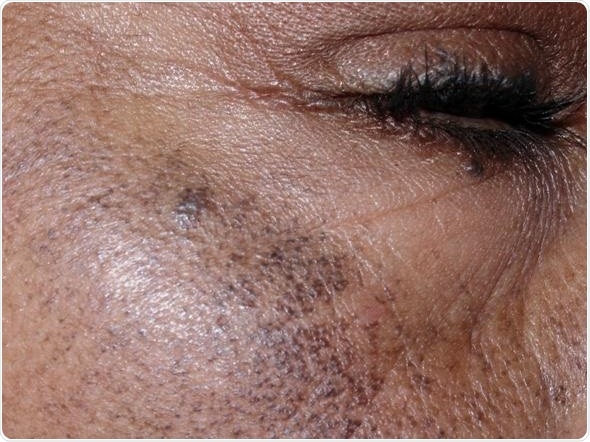Ochronosis is a rare disorder which manifests as a bluish-black discoloration of the skin and mucosa. It is categorized into endogenous or exogenous forms.
Endogenous Ochronosis
This form is also referred to as alkaptonuria (black urine disease). It is an autosomal recessive disease which is caused by inheriting a genetic defect in the enzyme homogentisate 1,2-dioxygenase (homogentisic acid oxidase or HGD). HGD has a role in the catabolism of the amino acids phenylalanine and tyrosine.
When HGD is functionally deficient (as is the case in alkaptonuria), there is an accumulation of homogentisic acid (HGA), a toxic by-product of tyrosine metabolism, in the liver. This occurs because HGD uses HGA as a substrate to convert it into maleylacetoacetic acid. In HGD deficiency, some of the HGA is excreted in urine, and oxidized in the air into benzoquinone acetate (BQA). This compound then undergoes polymerization to yield a black colour.

Unfortunately, small quantities remain in the body, progressively accumulating in the connective tissues (bones, skin and cartilage) where it turns into a brownish-black pigmented polymeric material characteristic of ochronosis.
Exogenous Ochronosis
This is a localized form of ochronosis which usually presents in areas of the skin where topical hydroquinone cream has been applied. This chemical is present in certain skin-lightening lotions and creams. It is also used to treat hyperpigmentation problems such as melasma. Even though the proportion of hydroquinone present in some of these creams is as low as 2%, it may still cause ochronosis with prolonged use.
There is understandable cause for concern as the annual sales of such skin-whitening products continue to rise by the millions, particularly if their prolonged use might result in an increased incidence of exogenous ochronotic lesions.
In addition to the two aforementioned causes for ochronosis, it may also develop following exposure to substances such as mercury, benzene and certain anti-malarials.
Symptoms of Ochronosis
This disease may first be noticed in infancy by observing that the urine is much darker than normal. Unfortunately, it is rare that the condition is diagnosed this early, because the urine turns dark only after being exposed to air for several hours.
most individuals remain asymptomatic until later in life. It may be in adulthood that they develop the characteristic bluish-black discoloration of connective and other tissues within the body.
Affected people may exhibit pigmentary changes of the skin which overlies collagenous structures such as the external ear or the tip of the nose, in addition to the sclera (the white of the eyes). Another common presentation is for patients to suffer from progressive arthritis and spine, hip, knee and shoulder joint problems which require surgical intervention.
Treatment
Currently there is no specific treatment for alkaptonuria. Most physicians recommend dietary restriction of the amino acids phenylalanine and tyrosine. This could subsequently decrease the quantity of HGA produced in the body, and so ultimately minimize future complications.
A diet which is rich in vitamin C (1g/day) may also be beneficial. Vitamin C has been found to slow down the conversion of HGA to the pigmented deposits in connective tissue.
There has also been recent research on the use of nitisinone, a potent inhibitor of the second enzyme in the tyrosine catabolic pathway. While this has not proven effective in reversing or removing existing ochronotic deposits, it possesses the capability to arrest the deposition process.
References
Last Updated: Feb 27, 2019